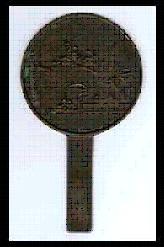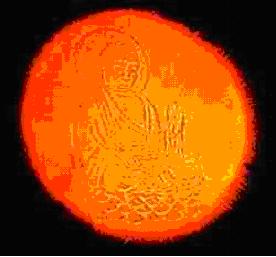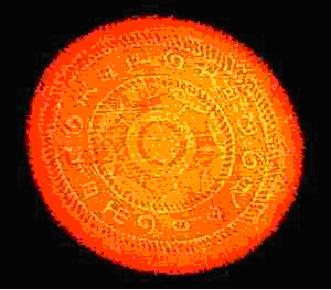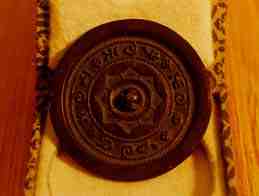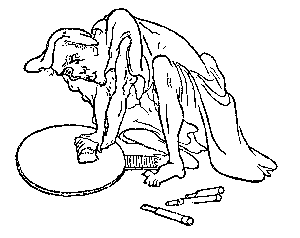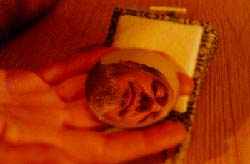Through the looking glass
Through the Looking Glass
by George Auckland.
Twenty years ago I saw the nearest thing I can describe to pure natural "magic". I was talking to Bill Coates, the senior demonstrator at the Royal Institution in London, and he was holding an object that looked a bit like a small crepe pan. It was a metal disk a few inches in diameter, with a handle. In fact it was a bronze mirror with a surface so highly polished we could see our faces in it. On the back was an oriental picture in low relief. Bill struck an open carbon arc ( he just loved doing that kind of thing) and moved about twelve feet away. He reflected the light from the mirror onto the white wall of the lecture theatre. There in front of me was a large image of the Buddha. Later, when I took a close look at the surface of the mirror, I could find no tell-tale signs of any such image. I've been fascinated by Magic Mirrors ever since that day.
Magic Mirrors come from China and Japan. They became popular in Europe in the early part of the 19th century and many distinguished scientist have attempted to explain the phenomenon. Here are some images from the mirrors in my collection.
Although this is from a modern mirror, this is exactly the sort of image Bill Coates showed me, 20 year ago. Note that this is the image produced by the mirror - there is no image visible at all on the reflecting face of the mirror.
This images corresponds exactly to the relief image on the back of the mirror
This shows the back of the mirror that gives the image just seen - to all intents and purposes, this relief image is identical to the 'magic' image produced by the front of the mirror. These are "modern" mirrors, in that they have been made recently, unlike the mirror I saw at The Royal Institution. To make these images we used a 150 watt quartz iodine lamp placed about six inches behind an aluminium foil screen, in which we had made a small hole with a pencil. We fixed each mirror in an upright position about six feet (two metres) away from the light source and projected the images onto a white screen quite close to the mirror. After a little experimenting this seemed to give the sharpest picture with adequate brightness to get an exposure reading. Superficially there seem to be two kinds of magic mirror, those which produce images similar to the relief patterns on their backs, thus giving the illusion of being "transparent", and those which produce a totally different image from the relief on the back. This difference may be just a deception. It may also explain why there are so many theories about how they work, how they are (were) made and how the effect can be recreated "on the kitchen table".
Not all Magic Mirrors are "Magic"
Magic Mirrors of this type, with a handle, can sometimes be seen in antique shops and at specialised auctions. For the collector they are beautiful objects with elaborate, finely worked relief patterns on one face. Unless the mirror has been well protected the "shiny" face will usually be dull and damaged and unlikely to work, even as a normal mirror. The mirror surface needs to be in very good condition and should also be slightly convex, although this is not always obvious. Even so the mirror may not be "magic". It seems that some Japanese mirrors are magic and some are not, although I understand that most Chinese mirrors are magic.
A bit of optics
If you did any optics at school you may have been taught that for a mirror to produce a "real image" (that is, one that can be projected onto a screen) the mirror must be concave. Large astronomical telescopes use huge concave mirrors. For a lens to produce a real image it must be convex; fatter in the middle than at the edges. Concave lenses and convex mirrors form Virtual Images, which can be seen using another lens or directly with our eyes, but they cannot form real images on a screen. So there seems to be a bit of a paradox. The magic mirror is slightly convex but it certainly produces a real image on a screen.
Historical
The earliest British reference I can find so far is in the Philosophical Magazine 1832:- "Account of a curious Chinese Mirror, which reflects from it's polished Face the Figures embossed upon it's Back. By Sir D. Brewster K.H. LLD"
(Sir David Brewster 1781-1868 was a Scottish physicist famous for the discovery of polarisation of light by reflection. When light is reflected from a non-metallic surface, such as glass, partial polarisation occurs. He invented the kaleidoscope, another delightful optical toy). Brewster refers to an account he has just received from George Swinton of Calcutta, about a curious metallic mirror recently brought from China to Calcutta, which was "amusing the dilettante and perplexing the philosophers" of that city. Swinton suggests that the mirrors are made by stamping and that this produces a difference in the density in different parts of the metal, the light being reflected more or less strongly from parts that have been more or less compressed. Brewster, being an expert in the polarisation of light, first of all suggests that might be the answer. "It is well known that silver polished by hammering acts differently upon light from silver that has received a specular polish." Then he suggests that the reflected image was not an image of the figures on the back of the mirror but a deliberate deception. The figures are a copy of the picture which the artist has drawn on the face of the mirror and then concealed by polishing. Brewster also proposes that the figure may be eaten out by a dilute acid, so as to remove the smallest possible portion of the metal. The surface can then be polished with a cloth so that the sunken parts will be as highly polished as the rest. He finally recommends that magic mirror might "furnish a lucrative article of trade"
In 1875 Dr. Geerts published a paper in the Transactions of the Asiatic society of Japan where he described in some detail how the magic mirrors were cast. He gave the metal mixture for the best mirrors made in Kyoto as :-
Lead---5 parts Tin----15 parts Copper-80 parts
After the mirrors have been well polished they are covered with a layer of mercury amalgam. " The amalgam is rubbed vigorously with a piece of soft leather, which manipulation must continue for a long time until the excess of mercury is expelled and the mirror has got a bright, reflecting surface."
On 24th May 1877 Professor R.W. Atkinson of Tokyo University published a letter in Nature describing a magic mirror he had been shown by a friend. "Considering the mode of manufacture I was led to suppose that the pressure to which the mirror was subjected during polishing, and which is greatest on the parts in relief, was conserved in the production of the figures. On putting this to the test by rubbing the back of the mirror with a blunt pointed instrument, and permitting the rays of the sun to be reflected from the front surface, a bright line appeared in the image corresponding to the position of the rubbed part. This experiment is quite easy to repeat, a scratch with a knife or with any other hard body is sufficient. It would seem as if the pressure upon the back during the polishing caused some change in the reflecting surface corresponding to the raised parts whereby the amount of the light reflected was greater; or supposing that of the light which falls upon the surface, a part is absorbed and the rest is reflected, those parts corresponding to the raised portions on the back are altered by the pressure in such a way that less is absorbed, and therefore a bright image appears."
On the 12th December 1878, Professors W.E Ayrton and John Perry of the Imperial College of Engineering in Japan published a detailed paper in the Proceedings of the Royal Society which really got down to the optics of Magic Mirrors. They reviewed the literature and also referred to an exhibition of the Japanese mirror by Professor Pepper ( he of the "Ghost") at the Polytechnic Institute in London. As a result of seeing Professor Peppers experiment an English brassworker, who was under the false impression that the mirrors were stamped, attempted to solve the problem. "The workman found that by taking ordinary brass and stamping it's surface with any suitable die, not once, but three times in succession, upon exactly the same spot, grinding down and polishing between each act of stamping, a molecular difference was established between the stamped and the unstamped parts, so that the images of the pattern could be reflected from the polished surface, just as with the Japanese specula, though no difference of the surface could be detected with the eye." Clearly this was not the authentic method of producing magic mirrors but it seems to have produced a working result.
Ayrton and Perry tried to find references to the magic mirror in Japanese literature but could not find any. (Have any come to light since?) But there are many in Chinese books. Needham (Science and Civilisation in China, Cambridge 1963) refers to a magic mirror owned by Wang Tu, a Chinese official in the 5th century AD.
An article in No.29 of "Gartenlaube", Heft 8, 1877 by Carus Sterne remarks that the Roman writer Aulus Gellius who lived in the 3rd century AD refers to "mirrors that sometimes reflect their backs and sometimes do not". Sterne also refers to an account by the Italian historian Muratori of the magic mirror found under the pillow of the Bishop of Verona, who was afterwards condemned to death by Martin della Scala.
Ayrton and Perry conducted a series of optical experiments to determine the nature of the surface of the mirrors. They used converging, parallel and diverging beams of light, a variety of lenses and a polariscope. They could detect no differences in the polarisation of the light from different parts of the surface, so they eliminated Sir Dave Brewster’s suggestion. "We have strong reasons for favouring the inequality of curvature theory..... not only do we think that the thicker portions of the convex mirror are flatter than the remainder but in some instances the thicker portion is actually concave with a radius of 3 to 4 metres."
In his book "Light visible and invisible" (1897) Professor Silvanus P. Thompson explains how this variation on curvature comes about. The mirrors are cast in moulds. To polish their faces they are laid on their backs by the workman, who scrapes them violently with a round iron rod about a half an inch in diameter and a foot long, called a "megebo" or distorting rod. During the process the mirror surface becomes slightly convex. As the work progresses the thinner parts of the mirror bend and give to the tool more than the thicker parts which lie over the pattern on the back. When the pressure of the scraper is relieved the thinner parts spring back and rise slightly above the average level of the mirror surface.
More recent research by Herbert Maryon, published in the Archives of the Chinese Art Society of America (1963) suggested that the English Brassworker's method of stamping should not be so lightly dismissed. Perhaps there are two methods of producing Magic Mirrors, one by Casting, scraping and polishing, and another by casting, scraping, punching or stamping, followed by more scraping and polishing and punching. Maybe the punching produces localised hardening of the metal so that it reacts slightly differently to the scraper. When the bumps on the face produced by punching on the back are removed some of the forces caused by the hardened particles of the metal spring back.
More research by Cyril Stanley Smith of M.I.T. also published in "Chinese Art of American Society" showed the punched grooves in photomicrographs of magic mirrors. This method could account for the fact that certain mirrors show an image of the relief picture on the back and some show another image altogether. If you can find a small convex mirror you can use it to produce a real image on a screen simply by fixing a small piece of opaque adhesive tape to the front surface. If you want to be more subtle use a wax crayon or a transparent water-soluble gum.
The front of a magic mirror is generally extremely shiny, and forms an excellent mirror. We would be interested to hear from anyone with magic mirrors and about any experiments you have tried to recreate their effects.
